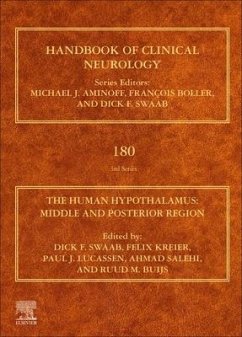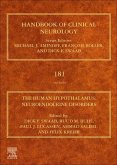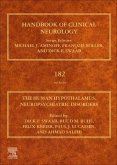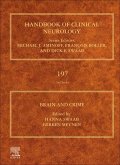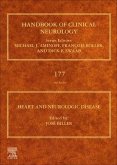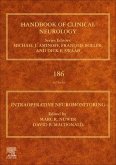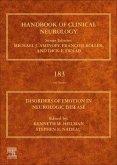The Human Hypothalamus
Middle and Posterior Region Volume 180
Herausgeber: Swaab, Dick F; Buijs, Ruud M; Salehi, Ahmad; Lucassen, Paul J; Kreier, Felix
The Human Hypothalamus
Middle and Posterior Region Volume 180
Herausgeber: Swaab, Dick F; Buijs, Ruud M; Salehi, Ahmad; Lucassen, Paul J; Kreier, Felix
- Gebundenes Buch
- Merkliste
- Auf die Merkliste
- Bewerten Bewerten
- Teilen
- Produkt teilen
- Produkterinnerung
- Produkterinnerung
The Hypothalamus is an important area of the brain for understanding a variety of neurological disorders. This volume summarizes for readers the anatomy and physiology of the middle and posterior hypothalamus, to better understand pathology and treatment of hypothalamus related disorders. In addition to anatomy and physiology in humans, cytoarchitecture and chemoarchitecture in rodents is provided. The volume explores the role of the hypothalamus in disorders of eating, sleeping, anxiety, and mood, as well as its role in sexual behavior and gender identity. Coverage includes how Parkinson's,…mehr
Andere Kunden interessierten sich auch für
![The Human Hypothalamus The Human Hypothalamus]() The Human Hypothalamus241,99 €
The Human Hypothalamus241,99 €![The Human Hypothalamus The Human Hypothalamus]() The Human Hypothalamus241,99 €
The Human Hypothalamus241,99 €![The Human Hypothalamus The Human Hypothalamus]() The Human Hypothalamus241,99 €
The Human Hypothalamus241,99 €![Brain and Crime Brain and Crime]() Brain and Crime241,99 €
Brain and Crime241,99 €![Heart and Neurologic Disease Heart and Neurologic Disease]() Heart and Neurologic Disease241,99 €
Heart and Neurologic Disease241,99 €![Intraoperative Neuromonitoring Intraoperative Neuromonitoring]() Intraoperative Neuromonitoring241,99 €
Intraoperative Neuromonitoring241,99 €![Disorders of Emotion in Neurologic Disease Disorders of Emotion in Neurologic Disease]() Disorders of Emotion in Neurologic Disease241,99 €
Disorders of Emotion in Neurologic Disease241,99 €-
-
-
The Hypothalamus is an important area of the brain for understanding a variety of neurological disorders. This volume summarizes for readers the anatomy and physiology of the middle and posterior hypothalamus, to better understand pathology and treatment of hypothalamus related disorders. In addition to anatomy and physiology in humans, cytoarchitecture and chemoarchitecture in rodents is provided. The volume explores the role of the hypothalamus in disorders of eating, sleeping, anxiety, and mood, as well as its role in sexual behavior and gender identity. Coverage includes how Parkinson's, Alzheimer's and other neurological disorders relate to the hypothalamus.
Produktdetails
- Produktdetails
- Verlag: Elsevier Science
- Seitenzahl: 548
- Erscheinungstermin: 14. September 2021
- Englisch
- Gewicht: 1440g
- ISBN-13: 9780128201077
- ISBN-10: 012820107X
- Artikelnr.: 60981612
- Herstellerkennzeichnung
- Libri GmbH
- Europaallee 1
- 36244 Bad Hersfeld
- gpsr@libri.de
- Verlag: Elsevier Science
- Seitenzahl: 548
- Erscheinungstermin: 14. September 2021
- Englisch
- Gewicht: 1440g
- ISBN-13: 9780128201077
- ISBN-10: 012820107X
- Artikelnr.: 60981612
- Herstellerkennzeichnung
- Libri GmbH
- Europaallee 1
- 36244 Bad Hersfeld
- gpsr@libri.de
1. Introduction: The middle and posterior hypothalamus
SECTION 6 Supraoptic and paraventricular nucleus more than a
neuroendocrine system
2. Vasopressin and oxytocin beyond the pituitary in the human brain
3. Central and peripheral release of oxytocin: Relevance of neuroendocrine
and neurotransmitter actions for physiology and behavior
4. Organization of the neuroendocrine and autonomic hypothalamic
paraventricular nucleus
5. Sex differences of oxytocin and vasopressin in social behaviors
6. Oxytocin, eating behavior, and metabolism in humans
7. The supraoptic and paraventricular nuclei in healthy aging and
neurodegeneration
8. Perinatal stress and epigenetics
9. The hypothalamus in anxiety disorders
10. Congenital isolated central hypothyroidism: Novel mutations and their
functional implications
SECTION 7 Zona incerta
11. The zona incerta system: Involvement in attention and movement
SECTION 8 Ventromedial nucleus and dorsomedial nucleus
12. The role of the dorsomedial and ventromedial hypothalamus in regulating
behaviorally coupled and resting autonomic drive
SECTION 9 Circumventricular organs of the hypothalamus
13. The subfornical organ and organum vasculosum of the lamina terminalis:
Critical roles in cardiovascular regulation and the control of fluid
balance
14. Lamina terminalis fenestration: An important neurosurgical corridor
15. Arcuate nucleus, median eminence, and hypophysial pars tuberalis
16. Tanycytes in the infundibular nucleus and median eminence and their
role in the blood-brain barrier
17. The human hypothalamic kisspeptin system: Functional neuroanatomy and
clinical perspectives
18. Kisspeptin and neurokinin B expression in the human hypothalamus:
Relation to reproduction and gender identity
19. The infundibular peptidergic neurons and glia cells in overeating,
obesity, and diabetes
20. Hypothalamus and weight loss in amyotrophic lateral sclerosis
SECTION 10 Lateral tuberal nucleus
SECTION 11 Lateral hypothalamic area, perifornical area
21. The orexin/hypocretin system in neuropsychiatric disorders: Relation to
signs and symptoms
22. Pleasure, addiction, and hypocretin (orexin)
SECTION 12 Tuberomamillary complex
23. Histamine receptors, agonists, and antagonists in health and disease
24. The tuberomamillary nucleus in neuropsychiatric disorders
SECTION 13 Subthalamic nucleus
25. Imaging of the human subthalamic nucleus
26. Neuropsychiatric effects of subthalamic deep brain stimulation
27. The subthalamic nucleus and the placebo effect in Parkinson's disease
SECTION 14 Corpora mamillaria, fornix, and mamillothalamic tract
28. Electrical stimulation of the fornix for the treatment of brain
diseases
29. The contribution of mamillary body damage to Wernicke's encephalopathy
and Korsakoff's syndrome
SECTION 6 Supraoptic and paraventricular nucleus more than a
neuroendocrine system
2. Vasopressin and oxytocin beyond the pituitary in the human brain
3. Central and peripheral release of oxytocin: Relevance of neuroendocrine
and neurotransmitter actions for physiology and behavior
4. Organization of the neuroendocrine and autonomic hypothalamic
paraventricular nucleus
5. Sex differences of oxytocin and vasopressin in social behaviors
6. Oxytocin, eating behavior, and metabolism in humans
7. The supraoptic and paraventricular nuclei in healthy aging and
neurodegeneration
8. Perinatal stress and epigenetics
9. The hypothalamus in anxiety disorders
10. Congenital isolated central hypothyroidism: Novel mutations and their
functional implications
SECTION 7 Zona incerta
11. The zona incerta system: Involvement in attention and movement
SECTION 8 Ventromedial nucleus and dorsomedial nucleus
12. The role of the dorsomedial and ventromedial hypothalamus in regulating
behaviorally coupled and resting autonomic drive
SECTION 9 Circumventricular organs of the hypothalamus
13. The subfornical organ and organum vasculosum of the lamina terminalis:
Critical roles in cardiovascular regulation and the control of fluid
balance
14. Lamina terminalis fenestration: An important neurosurgical corridor
15. Arcuate nucleus, median eminence, and hypophysial pars tuberalis
16. Tanycytes in the infundibular nucleus and median eminence and their
role in the blood-brain barrier
17. The human hypothalamic kisspeptin system: Functional neuroanatomy and
clinical perspectives
18. Kisspeptin and neurokinin B expression in the human hypothalamus:
Relation to reproduction and gender identity
19. The infundibular peptidergic neurons and glia cells in overeating,
obesity, and diabetes
20. Hypothalamus and weight loss in amyotrophic lateral sclerosis
SECTION 10 Lateral tuberal nucleus
SECTION 11 Lateral hypothalamic area, perifornical area
21. The orexin/hypocretin system in neuropsychiatric disorders: Relation to
signs and symptoms
22. Pleasure, addiction, and hypocretin (orexin)
SECTION 12 Tuberomamillary complex
23. Histamine receptors, agonists, and antagonists in health and disease
24. The tuberomamillary nucleus in neuropsychiatric disorders
SECTION 13 Subthalamic nucleus
25. Imaging of the human subthalamic nucleus
26. Neuropsychiatric effects of subthalamic deep brain stimulation
27. The subthalamic nucleus and the placebo effect in Parkinson's disease
SECTION 14 Corpora mamillaria, fornix, and mamillothalamic tract
28. Electrical stimulation of the fornix for the treatment of brain
diseases
29. The contribution of mamillary body damage to Wernicke's encephalopathy
and Korsakoff's syndrome
1. Introduction: The middle and posterior hypothalamus
SECTION 6 Supraoptic and paraventricular nucleus more than a
neuroendocrine system
2. Vasopressin and oxytocin beyond the pituitary in the human brain
3. Central and peripheral release of oxytocin: Relevance of neuroendocrine
and neurotransmitter actions for physiology and behavior
4. Organization of the neuroendocrine and autonomic hypothalamic
paraventricular nucleus
5. Sex differences of oxytocin and vasopressin in social behaviors
6. Oxytocin, eating behavior, and metabolism in humans
7. The supraoptic and paraventricular nuclei in healthy aging and
neurodegeneration
8. Perinatal stress and epigenetics
9. The hypothalamus in anxiety disorders
10. Congenital isolated central hypothyroidism: Novel mutations and their
functional implications
SECTION 7 Zona incerta
11. The zona incerta system: Involvement in attention and movement
SECTION 8 Ventromedial nucleus and dorsomedial nucleus
12. The role of the dorsomedial and ventromedial hypothalamus in regulating
behaviorally coupled and resting autonomic drive
SECTION 9 Circumventricular organs of the hypothalamus
13. The subfornical organ and organum vasculosum of the lamina terminalis:
Critical roles in cardiovascular regulation and the control of fluid
balance
14. Lamina terminalis fenestration: An important neurosurgical corridor
15. Arcuate nucleus, median eminence, and hypophysial pars tuberalis
16. Tanycytes in the infundibular nucleus and median eminence and their
role in the blood-brain barrier
17. The human hypothalamic kisspeptin system: Functional neuroanatomy and
clinical perspectives
18. Kisspeptin and neurokinin B expression in the human hypothalamus:
Relation to reproduction and gender identity
19. The infundibular peptidergic neurons and glia cells in overeating,
obesity, and diabetes
20. Hypothalamus and weight loss in amyotrophic lateral sclerosis
SECTION 10 Lateral tuberal nucleus
SECTION 11 Lateral hypothalamic area, perifornical area
21. The orexin/hypocretin system in neuropsychiatric disorders: Relation to
signs and symptoms
22. Pleasure, addiction, and hypocretin (orexin)
SECTION 12 Tuberomamillary complex
23. Histamine receptors, agonists, and antagonists in health and disease
24. The tuberomamillary nucleus in neuropsychiatric disorders
SECTION 13 Subthalamic nucleus
25. Imaging of the human subthalamic nucleus
26. Neuropsychiatric effects of subthalamic deep brain stimulation
27. The subthalamic nucleus and the placebo effect in Parkinson's disease
SECTION 14 Corpora mamillaria, fornix, and mamillothalamic tract
28. Electrical stimulation of the fornix for the treatment of brain
diseases
29. The contribution of mamillary body damage to Wernicke's encephalopathy
and Korsakoff's syndrome
SECTION 6 Supraoptic and paraventricular nucleus more than a
neuroendocrine system
2. Vasopressin and oxytocin beyond the pituitary in the human brain
3. Central and peripheral release of oxytocin: Relevance of neuroendocrine
and neurotransmitter actions for physiology and behavior
4. Organization of the neuroendocrine and autonomic hypothalamic
paraventricular nucleus
5. Sex differences of oxytocin and vasopressin in social behaviors
6. Oxytocin, eating behavior, and metabolism in humans
7. The supraoptic and paraventricular nuclei in healthy aging and
neurodegeneration
8. Perinatal stress and epigenetics
9. The hypothalamus in anxiety disorders
10. Congenital isolated central hypothyroidism: Novel mutations and their
functional implications
SECTION 7 Zona incerta
11. The zona incerta system: Involvement in attention and movement
SECTION 8 Ventromedial nucleus and dorsomedial nucleus
12. The role of the dorsomedial and ventromedial hypothalamus in regulating
behaviorally coupled and resting autonomic drive
SECTION 9 Circumventricular organs of the hypothalamus
13. The subfornical organ and organum vasculosum of the lamina terminalis:
Critical roles in cardiovascular regulation and the control of fluid
balance
14. Lamina terminalis fenestration: An important neurosurgical corridor
15. Arcuate nucleus, median eminence, and hypophysial pars tuberalis
16. Tanycytes in the infundibular nucleus and median eminence and their
role in the blood-brain barrier
17. The human hypothalamic kisspeptin system: Functional neuroanatomy and
clinical perspectives
18. Kisspeptin and neurokinin B expression in the human hypothalamus:
Relation to reproduction and gender identity
19. The infundibular peptidergic neurons and glia cells in overeating,
obesity, and diabetes
20. Hypothalamus and weight loss in amyotrophic lateral sclerosis
SECTION 10 Lateral tuberal nucleus
SECTION 11 Lateral hypothalamic area, perifornical area
21. The orexin/hypocretin system in neuropsychiatric disorders: Relation to
signs and symptoms
22. Pleasure, addiction, and hypocretin (orexin)
SECTION 12 Tuberomamillary complex
23. Histamine receptors, agonists, and antagonists in health and disease
24. The tuberomamillary nucleus in neuropsychiatric disorders
SECTION 13 Subthalamic nucleus
25. Imaging of the human subthalamic nucleus
26. Neuropsychiatric effects of subthalamic deep brain stimulation
27. The subthalamic nucleus and the placebo effect in Parkinson's disease
SECTION 14 Corpora mamillaria, fornix, and mamillothalamic tract
28. Electrical stimulation of the fornix for the treatment of brain
diseases
29. The contribution of mamillary body damage to Wernicke's encephalopathy
and Korsakoff's syndrome

